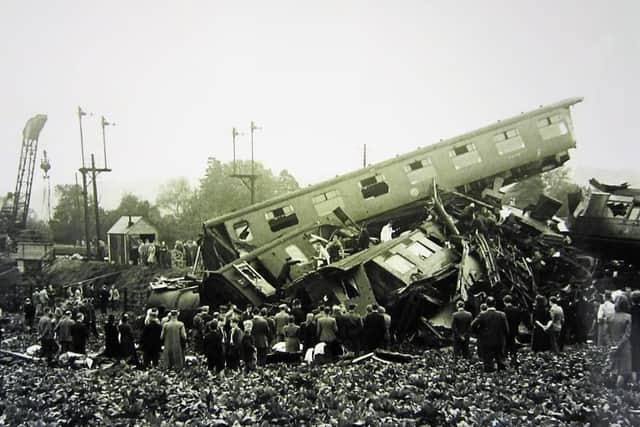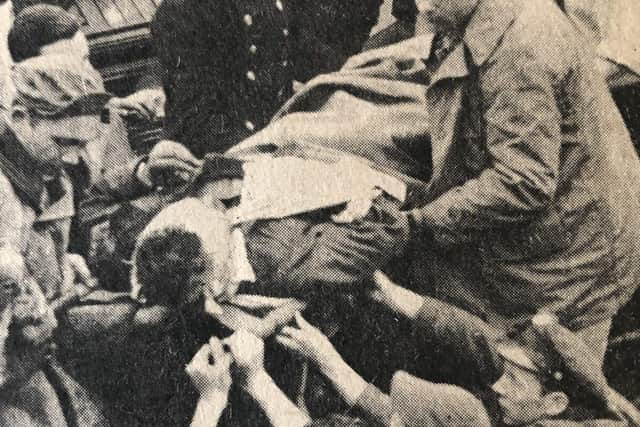The Bourne End Rail Crash; A Forgotten Tragedy
and live on Freeview channel 276
In the early hours of the morning on Sunday, the 30th of September 1945, the ‘Royal Artilleryman’, from Perth to Euston, derailed at Bourne End just next to the signal box.
The train was said to be travelling between 50 and 70mph. Of the 700 passengers, including children, servicemen and brides-to-be, 43 tragically died and 64 were seriously injured. The youngest of the casualties was a 2-year-old boy.
Advertisement
Advertisement
Neil Fleming explained his father’s role in the event; “His name was Horace Wilfred Fleming, but everybody called him Bill. He was in the first fire engine at the scene,” he said. Mr Fleming explained that his father, a Section Leader in the National Fire Service, had 50 minutes left of his 24-hour shift when the call came in. He then worked for another 9 hours at the crash site.


The train “careered over the points, pulling the carriages with it. It was a hell of a mess.” said Mr Fleming. His father and his fellow firefighters from the nearest Hemel Hempstead fire station “tunnelled their way through the wreckage and managed to get one woman out.”
Of the 15 carriages, the first was completely crushed and the second and third were sticking out of the ground at a 45-degree. The remainder of the carriages, barring the last three which remained on the tracks, were stacked on top of each other around the area. Shoes, luggage and clothes were scattered around the scene.
American pilot, Captain McCallum, just minutes after taking off from the Bovingdon USAAF base, “watched the whole thing unfold,” said Mr Fleming, whose father had learnt these key details at the accident inquiry. The captain radioed the base, which then sent help to the wreck. Emergency services “had a lot of help from ground crew from the airbase,” said Mr Fleming.
Advertisement
Advertisement
Mr and Mrs Johnson from Pix Farmhouse, Bourne End village arrived at the scene after hearing the sharp squeal of escaping steam of the train’s engine. They alerted Berkhamsted emergency services who arrived at the scene to aid the injured as best they could. The first of them to arrive was a crew of firemen led by Bill Fleming.


“Then the fire engines carried very basic equipment for fighting during the blitz, nowadays they are so well equipped with specialist appliances,” said Mr Fleming. He explained it took a lot of effort to rescue survivors.
A doctor who survived the crash helped the injured. Within a few hours, Fire Services, The Red Cross, St. Johns nurses, Ex-Civil Defence workers, Women's Voluntary Service and locals arrived at the scene. Bourne End village was celebrating Victory over Japan Day with sandwiches, sausage rolls and tea, which were all quickly donated to survivors.
Injuries ranged from shock and bruising to fractures, breaks and amputations.
Advertisement
Advertisement
A World War II hospital based at Ashridge House, which had just shut due to the end of the war hurriedly reopened to take injured. Casualties were also sent to the West-Herts Hospital in Hemel Hempstead hospital and the dead, to the mortuary in Berkhamsted. Some passengers could only be identified by personal belongings.
On the 4th of October, the Ministry of War and Transport Inquiry, headed by Lt. Col. Sir Alan Mount, was opened. “My father had to go the inquiry as the first fire officer to be there,” said Mr Fleming. The driver, Sidney Swaby had perished in the crash it was difficult to know exactly what happened. As a train had successfully passed the location just 10 minutes prior it was presumed that the crash was due to driver error. The speed restriction at the junction was 20mph but the train's speed was estimated to be much higher.
After investigation, it was found that the original driver of the train was sick, and a relief driver was called in who had been working for 26 days in a row due to post-war staff shortages. “He didn’t read the running notes. On the notes, there was a speed restriction.” Said, Mr Fleming. “There was another report that said smoke from the train line made it hard to see out of the porthole windows, he didn’t see the amber signals.”. "So, all in all, it was a catalogue of minor errors which ended up as a huge accident,” said Mr Fleming. The report concluded the crash was due to the train’s excessive speed.
One of the 43 killed was William Smith. John Smith, his Grandson, described him as a “proper rogue”. “He was always a bit of a drifter,” he said. “He came from a long line of mining families from central Scotland”.
Advertisement
Advertisement
He explained that the 26-year-old stole money from his place of employment and “headed for the fateful train”. Before boarding William took out two life insurance policies from a machine on the platform, paying “three pennies” for each. This is around 44p each today. John said how “very lucky” this eerie coincidence was as William died in the crash just hours later. “He died of a fractured skull; he was obviously one of the first to die in the original accident,” said Mr Smith.
William’s relatives only knew he had passed when money suddenly came into the family. They paid out at £19.15 and £23 and 11 shillings. “It was a lot of money back then,” said John. This is equivalent to approximately £2350 today.
There is no memorial for the victims of the crash. “I genuinely thought there was a memorial somewhere,” said Mr Smith. He said he didn’t even know where his grandfather was buried after the crash or if he was even in a marked grave.
“It doesn’t get much mention. There are people in Hemel that never knew it happened”. “Nobody ever talks about it, sometimes I say, my dad went on that and - oh crikey I didn’t know - they say,” said Mr Fleming.
Advertisement
Advertisement
78 years later houses line the track where the event happened and very few living in the village were witnesses of the event.
All that remains is the story passed down by families of those involved, and door handles found by locals with metal detectors over lockdown. The crash remains the 7th worst rail crash in Britain in terms of the death toll.